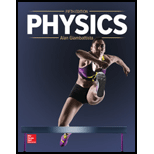
Concept explainers
(a)
Maximum height that can be reached by stone.
(a)
Answer to Problem 62P
Maximum height is
Explanation of Solution
Initial speed is
Write the Newton’s equation for an object moving vertically upwards.
Here, the velocity at the highest point of motion is
Conclusion:
Substitute
Rewrite the above relation in terms of
(b)
Total time taken by the stone for its whole journey before reaching the ground.
(b)
Answer to Problem 62P
Time taken is
Explanation of Solution
Initial speed is
Write the equation for time taken by the stone to reach the maximum height.
Here, the time taken by stone for its upward motion is
Write the equation for time taken by the stone for its downward motion.
Here, the time taken by stone for its downward motion is
Write the equation for total time taken by stone for its whole travelling before reaching he ground.
Here, the total time taken is
Conclusion:
Substitute
Substitute
Substitute
Therefore, the time taken is
Want to see more full solutions like this?
Chapter 2 Solutions
Physics
- kerjakanarrow_forwardAn object is placed 37.4cm in front of a diverging lens with a focal length of 18.1 cm. Please provide your answers in units of cm if necessary. bookmark_border1.0p3a Find the image distance. Answer Updated 6 days ago Show feedback bookmark_border1.0p3b Is the image real or virtual? Real Virtual Updated 6 days ago Show feedback bookmark_border1.0p3c Suppose the object is brought to a distance of 10.3 cm in front of the lens. Where is the image now with respect to its previous location? (Note: Ensure the sign convention you use is consistent by treating all image distances on the object side of the lens as negative.) Answer Updated 7 minutes ago Show feedback bookmark_border1.0p3d How has the height of the image changed if the object is 84.2 cm tall? Answerarrow_forwardn object is placed 37.4cm in front of a diverging lens with a focal length of 18.1 cm. Please provide your answers in units of cm if necessary. bookmark_border1.0p3a Find the image distance. Answer Updated 6 days ago Show feedback bookmark_border1.0p3b Is the image real or virtual? Real Virtual Updated 6 days ago Show feedback bookmark_border1.0p3c Suppose the object is brought to a distance of 10.3 cm in front of the lens. Where is the image now with respect to its previous location? (Note: Ensure the sign convention you use is consistent by treating all image distances on the object side of the lens as negative.) Answer Updated just now Show feedback bookmark_border1.0p3d How has the height of the image changed if the object is 84.2 cm tall? Answerarrow_forward
- Can you draw a FBD and KD please!arrow_forwardIf a 120- volt circuit feeds four 40-watt fluorescent lamps, what current (in amps) is drawn if the power factor is 0.912 0.33 0.68 1.21 3.3arrow_forwardHow do you draw a diagram of the ruler and mass system in equilibrium identifying the anti-clockwise torque and clockwise torque? How do I calculate the anti-clockwise torque and the clockwise torque of the system with the ruler and the washers, does it come from the data in table 2? Please help, thank you!arrow_forward
- A long, narrow steel rod of length 2.5000 m at 33.5°C is oscillating as a pendulum about a horizontal axis through one end. If the temperature drops to 0°C, what will be the fractional change in its period?arrow_forwardHow long should a pendulum be in order to swing back and forth in 1.6 s?arrow_forwardLECTURE HANDOUT: REFRACTION OF LIGHT I. Review Each of the diagrams at right shows a ray incident on a boundary between two media. Continue each of the rays into the second medium. Using a dashed line, also draw the path that the wave would have taken if it had continued without "bending." Does the ray representing a wave "bend" toward or away from the normal when: the wave speed is smaller in the second medium? ⚫the wave speed is larger in the second medium? Faster medium Slower medium Slower medium Faster medium II. Qualitative applications of refraction A. Place a coin at the bottom of an empty can or cup. Look into the cup at the coin while your partner slowly moves the can away from you until you no longer see the coin. Now, keep your head steady while your partner gently pours water into the cup. 1. Describe your observations. Switch roles with your partner so that you each have a turn. Shown below are cross-sectional diagrams of the cup for when it was empty and when it was…arrow_forward
 College PhysicsPhysicsISBN:9781305952300Author:Raymond A. Serway, Chris VuillePublisher:Cengage Learning
College PhysicsPhysicsISBN:9781305952300Author:Raymond A. Serway, Chris VuillePublisher:Cengage Learning University Physics (14th Edition)PhysicsISBN:9780133969290Author:Hugh D. Young, Roger A. FreedmanPublisher:PEARSON
University Physics (14th Edition)PhysicsISBN:9780133969290Author:Hugh D. Young, Roger A. FreedmanPublisher:PEARSON Introduction To Quantum MechanicsPhysicsISBN:9781107189638Author:Griffiths, David J., Schroeter, Darrell F.Publisher:Cambridge University Press
Introduction To Quantum MechanicsPhysicsISBN:9781107189638Author:Griffiths, David J., Schroeter, Darrell F.Publisher:Cambridge University Press Physics for Scientists and EngineersPhysicsISBN:9781337553278Author:Raymond A. Serway, John W. JewettPublisher:Cengage Learning
Physics for Scientists and EngineersPhysicsISBN:9781337553278Author:Raymond A. Serway, John W. JewettPublisher:Cengage Learning Lecture- Tutorials for Introductory AstronomyPhysicsISBN:9780321820464Author:Edward E. Prather, Tim P. Slater, Jeff P. Adams, Gina BrissendenPublisher:Addison-Wesley
Lecture- Tutorials for Introductory AstronomyPhysicsISBN:9780321820464Author:Edward E. Prather, Tim P. Slater, Jeff P. Adams, Gina BrissendenPublisher:Addison-Wesley College Physics: A Strategic Approach (4th Editio...PhysicsISBN:9780134609034Author:Randall D. Knight (Professor Emeritus), Brian Jones, Stuart FieldPublisher:PEARSON
College Physics: A Strategic Approach (4th Editio...PhysicsISBN:9780134609034Author:Randall D. Knight (Professor Emeritus), Brian Jones, Stuart FieldPublisher:PEARSON





